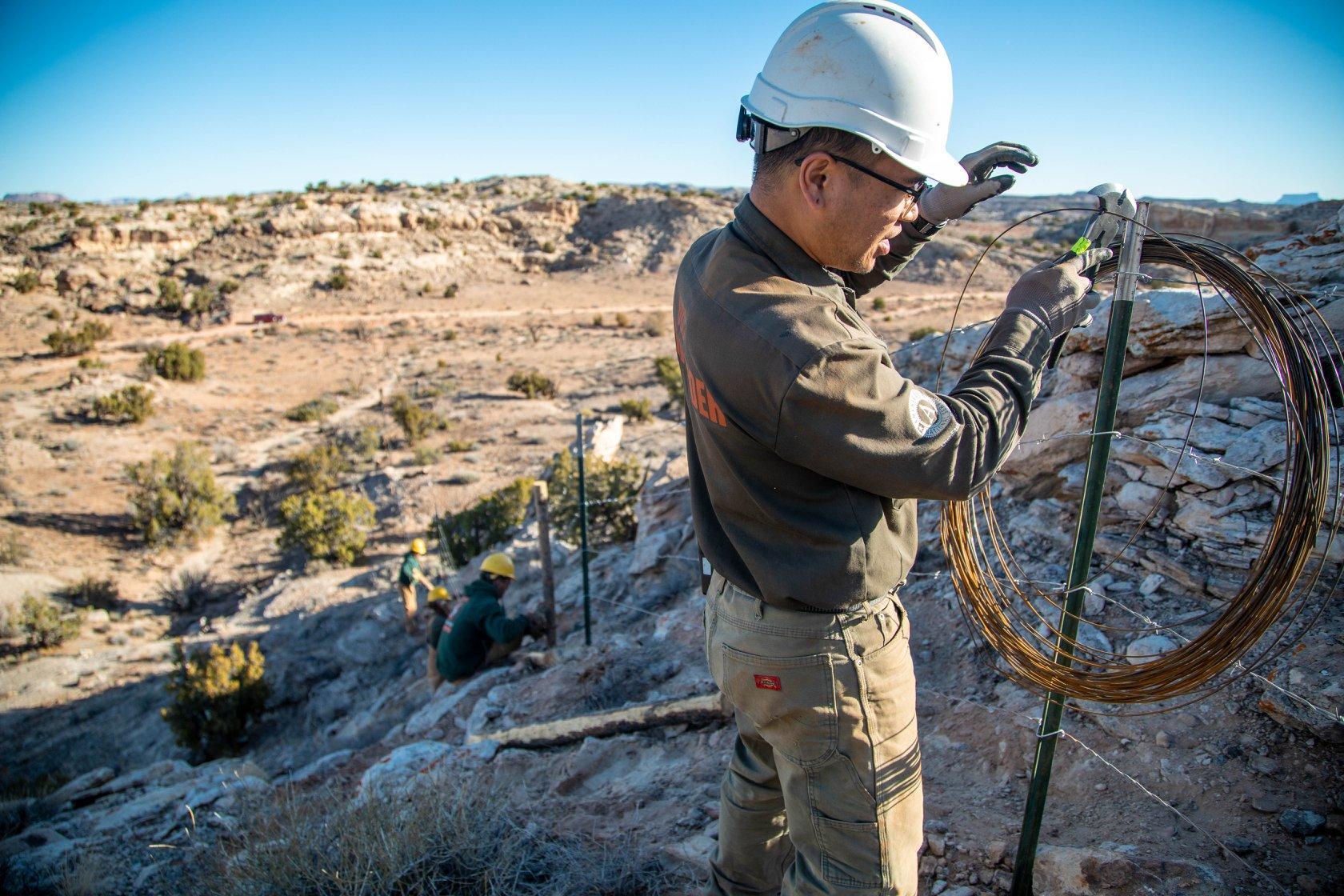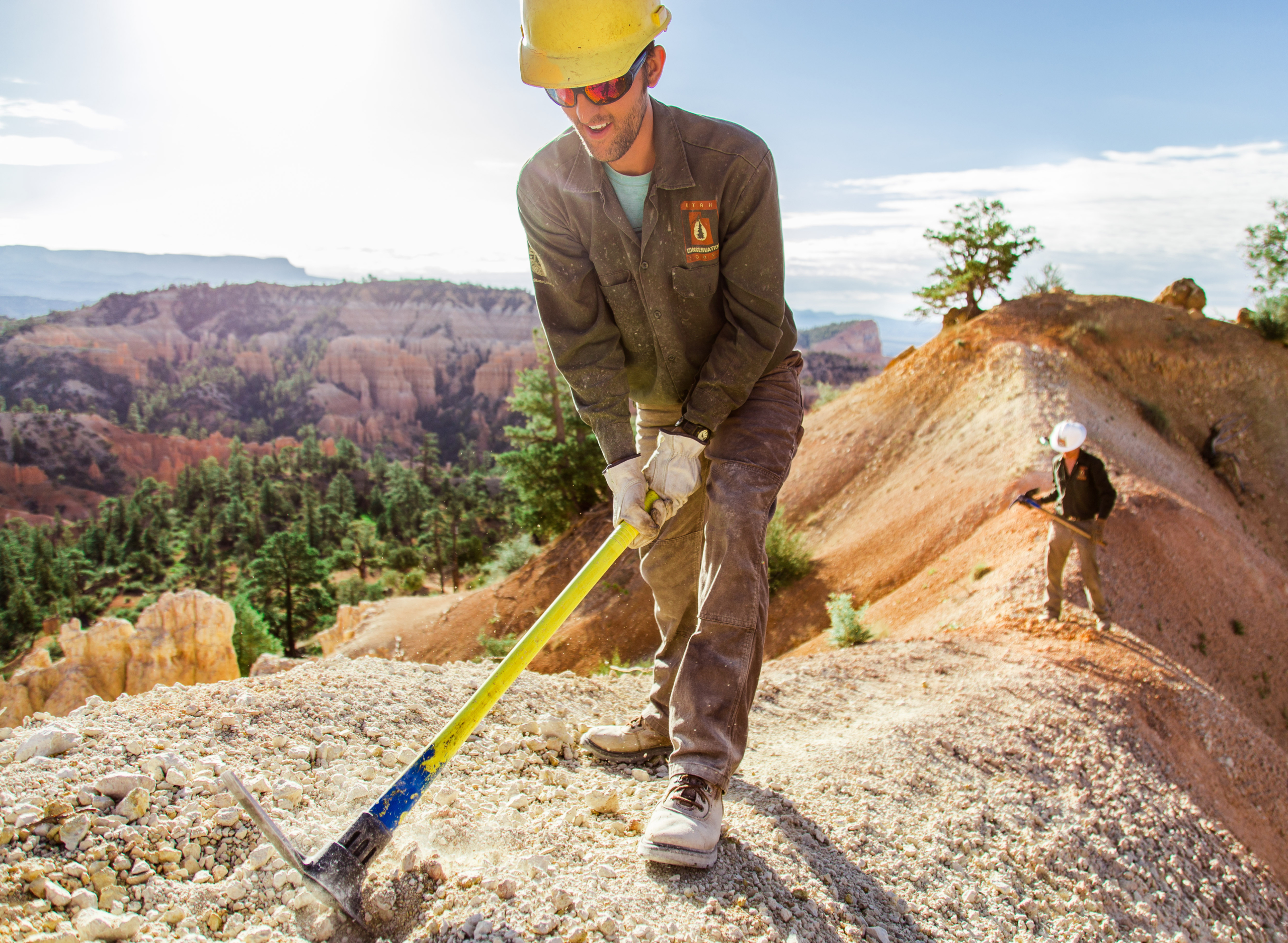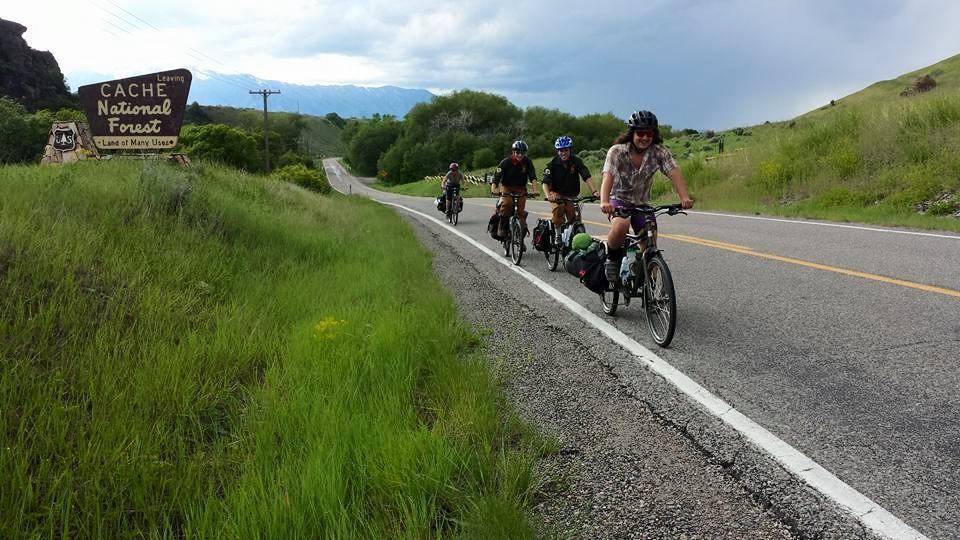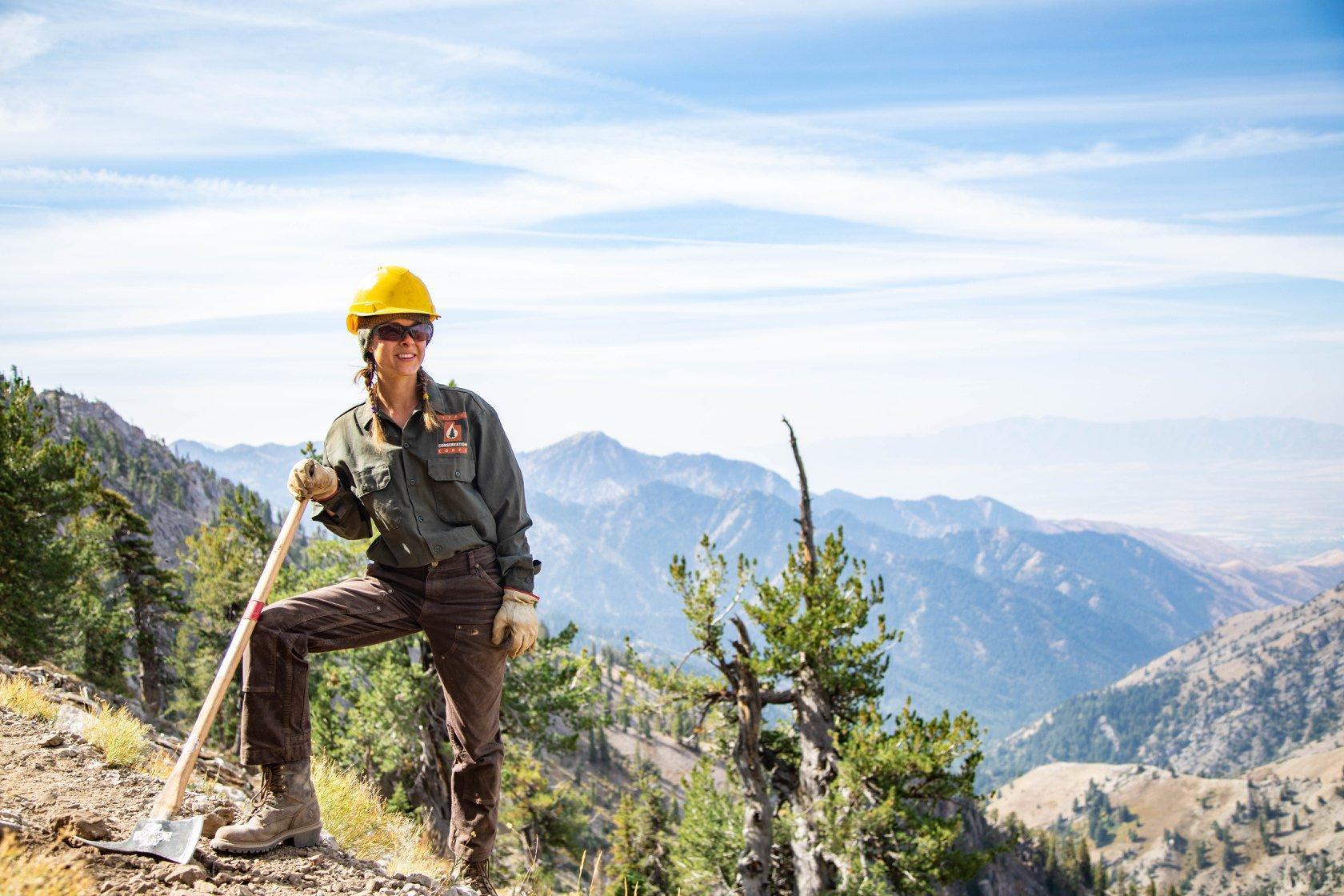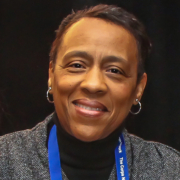
By Sydni Dobson
It’s been 20 years since Utah Conservation Corps (UCC) created its program under Utah State University. In honor of their 20 year anniversary, we spoke with UCC Director Sean Damitz to reflect on the history of the Corps and their future plans.
Could you tell us about the history of the Utah Conservation Corps (UCC) and what were some of the first projects that you all completed?
Sean: I was an AmeriCorps VISTA member serving at the Utah State University Val R. Christensen Service Center over 20 years ago and got with a bunch of folks that wanted to see a statewide Conservation Corps program, and I thought that it might be a fun idea if we got one started here in Utah. We’ve got a lot of young folks that really want to be involved in managing natural resources and we’ve got a lot of public land managers that have a lot of projects and increasing visitation.
That’s kind of a snippet of how we got started. We got some good support from Conservation Corps, making sure we didn’t reinvent the wheel and we had support from our umbrella organization at The Corps Network, which represents all the Conservation Corps throughout the country.
Since that time, we’ve been doing a lot of projects in terms of trail maintenance, habitat restoration, fuels reduction and other stuff like ADA surveys with Utah’s national forests. Most recently, we’ve been doing a lot more disaster response work as an AmeriCorps program all throughout the country.
The Corps Network actually gave a lot of support to the little working group that I led in the creation of the UCC. They gave us some technical support and sent me on a little road trip for a couple of weeks one summer to go out and visit a couple of Conservation Corps from Montana, Washington, and Oregon. They gave me gas and food money and I got to hang out and see how other people do it. It was a little blueprint of how to get the Conservation Corps off the ground. They were a wonderful service to our Corps.
Q: When you first started out, how did you recruit Corpsmembers?
Sean: I think that was in our initial first years of using the Internet to kind of grab folks. That first year we probably got 50 percent of folks who were local or heard of us through friends at Utah State University. Some folks found us by cruising the Internet looking for something interesting to do with their lives for six months to a year and wanted to do AmeriCorps and signed up for our program.
Q: Can you talk about the switch you all made from focusing on local to nation-wide recruiting?
Sean: I think we’ve always had a combination of local and national recruiting. With national recruiting, we’re trying to cast a really wide net in terms of trying to get good applicants and letting a diverse audience know that we have good opportunities here in Utah. We have tons of good projects with tons of good land managers. We’re just trying to fill all of our positions, especially in light of the Civilian Climate Corps legislation that’s coming through. We’re looking at our project partners that might have additional funding for us; that will make us see a significant bump in the number of project partners that we recruit well into 2022. We’re trying to be pretty cognizant on getting a diverse pool of applicants into those positions and have that good experience for all of our Corpsmembers.
Q: When you initially launched UCC, did you think that the program would be where it is today? Or did you see it forming in another way?
Sean: With the funding from The Corps Network right off the bat, and being able to see these different programs – like Montana Conservation Corps, Northwest Youth Corps and Washington Conservation Corps – they’re still bigger than we are today. It was eye opening to see that, but in the compounds of Utah State University, we wanted to do things a little differently. I think we’ve been given the luxury to do that, since we’ve had the university as a financial sponsor. We didn’t have the huge pressure to grow quickly at the cost of the quality of experience for Corpsmembers.
Thinking back to our 20 years when we did our first project, and I was out there with Corpsmembers, I was just ecstatic that it was actually happening and that we got this program off the ground. I still feel giddy, and I feel like I got away with one here. When I go out and visit members doing projects and think about how 20 years passed, a lot of things have changed with folks in this demographic range. I think a lot has changed for young people and it is different than the late 90s/early 2000s when we started.
I think the reassuring thing for me is that a lot of young folks want to do this and be a part of the Conservation Corps movement. That’s really inspiring to me.
Q: We know that UCC does a significant amount of work on public lands that were built by the Civilian Conservation Corps. Could you talk about some of those projects that you all are still working on and the significance of working on these sites?
Sean: Habitat restoration projects are the big ones that we’re involved in right now. We’re working on whole watersheds and want to cooperate with a number of Conservation Corps on different river watersheds. We’re starting to get into the meat of working on the White River, which is coincidentally now in my back yard and goes into Utah. Those are really good to show off because they demonstrate the collaboration between different land agencies and a number of Corps and nonprofit organizations all getting in to look at the watershed as a whole.
The other thing that has our attention is the fuels reduction piece that we do with the state and federal agencies. It’s super critical. We have this pressing need of trying to manage fire the best way we can in the age of climate change. It is good experience for our Corpsmembers, especially if they’re getting into more land management work.
How does UCC continue the legacy of the original CCC program and how are you different?
Sean: When the CCC started, folks were ecstatic that young people were getting in and doing those type of projects, whether that was maintaining trails or doing other types of soil conservation. I think that is really inspiring to have our members make that connection. We’re really trying to broaden that scope of what the CCC did in terms of projects. That’s where I see the Utah Conservation Corps and a lot of Conservation Corps in The Corps Network. We broadcast it to a wide, diverse audience, so that it can keep going in the future.
What makes your program unique from all other conservation programs?
Sean: We’ve had a staff who’s willing to try and support different initiatives. In 2005, we helped a student at Utah State University with a bicycle lending program. We’ve also done a lot with nonprofits that deal with environmental education. I think the benefits from my perspective are that it gives those young folks a really eye-opening experience of natural resource management into the national service role. It kind of gets their feet wet.
In my opinion we’re achieving our goal of the mission, which is to develop conservation leaders. It doesn’t matter if our folks are going to be public land managers, a nurse, doctor, lawyer, or schoolteacher or what not. I think at the end of the day, we’re happy with the experience that they have. That’s what I’m looking for, if we’ve done a great job with our program once, they’ve finished their service.
Heading into your third decade of conservation work, are there any unique projects that your Corps has currently in the works?
Sean: We’re trying to look at our carbon footprint as an organization and figuring out not only how to go carbon neutral, but also measure our impact as an organization towards our goal of carbon neutrality by 2030. I think it’s important as a Conservation Corps that we walk the walk and talk the talk in terms of our carbon footprint.
If we don’t recruit diverse audiences and make it a welcoming for people of all backgrounds, I don’t see us as a Corps or as a movement being able to stay relevant to young folks into the future. That’s what we need to do to: stay relevant in the future. In order to give our Corpsmembers good experiences, they have to know that we’re on our toes and doing the right things in terms of the future of this planet as an organization and the future of our organization and our community. We want to make sure that these experiences are open to a wide range of folks from all different backgrounds.
How does the UCC project portfolio help improve access to outdoor recreation?
Sean: When I think of access, Utah is such a great state for public lands access. In Utah, most places you can get on your bike and pedal for a few minutes and be in a pretty wild place or semi-wild place. In my opinion, recreational access is an equation of how we mitigate impacts from visitation and how those places can hold up to a lot of visitors and access doesn’t get limited. Land managers have to put certain areas off-limits, or they have to put quotas down because there are way too many people having an impact in an area. I think those are one of the major problems we have as a program, working on land management impact and mitigating the success of our own popularity and campaigns. We see a lot of visitors, which is a good thing because it brings a lot of revenue to the state and these small gateway communities that really benefit from having these visitors. We’re trying to figure out how to play a better partnering role.
With funding from the Great American Outdoors Act, what kind of programs does your Corps anticipate to take on the future?
Sean: We haven’t seen too much with Great American Outdoors Act funding. But I’m hoping that it goes back to a lot of what I was talking about in my previous question with mitigating acts of visitation with more popular public land management sites. In my mind, it’s one of the most critical needs that would serve the spirit of that legislation in getting to do projects that are well loved by the American taxpayer. If we can get other Corps to do that and really show the impact of how federal funding is an efficient way to partner with federal land management agencies to get those critical land management projects done, that will be big.
What does the next chapter look like for UCC?
Sean: We’re currently in the midst of our five-year strategic plan. I think the last year gave us a different perspective of where we’re going for the next five years. We’re trying to be carbon neutral by 2030. That’s a good goal of ours. If we can get other Corps excited about that and work with The Corps Network to kind of push that, we want all Corps to have the tools to manage their carbon footprint and to publicize that they’re part of this movement to minimize carbon impact and work with land management agencies on that.
The other thing that I think we’re really focusing on is that disaster response piece. Hurricane and flooding seasons aren’t going away. We want to be as nimble and flexible as we can as an organization to give folks the opportunity to serve on those disaster response crews and to serve fellow Americans in that time of need. I think that’s definitely something that we’ve been putting a lot of energy into. We love being part of that multiple Corps/AmeriCorps effort to go out and be ready for hurricane season or when floods get bad. We want to be part of that effort and play a vital role in it.
Overall, as a program we want to make sure that we’re a sound organization. We want to make sure with our mission, that at the end of the day we are giving Corpsmembers a really good experience in terms of developing their conservation skills whether they’re doing those vital fuel reduction projects, habitat restoration, or if they’re out in the middle of the wilderness


